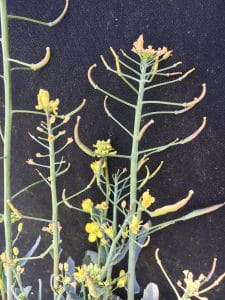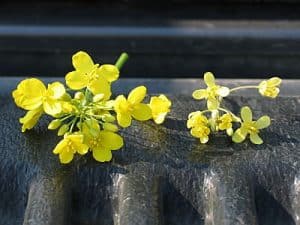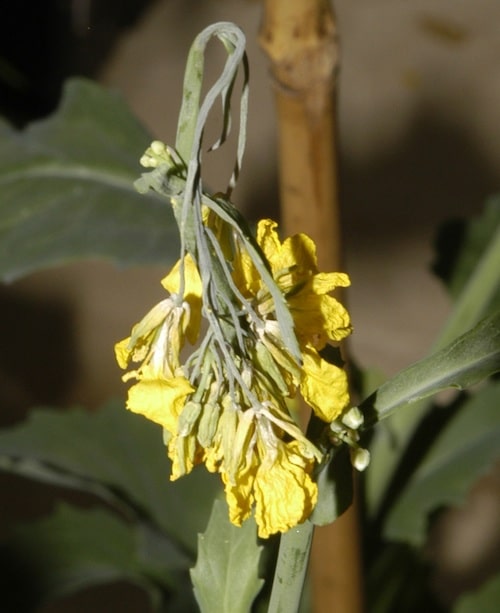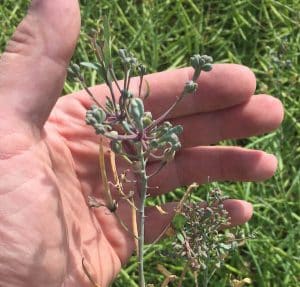While scouting for flower staging, canopy moisture and pod-feeding insects, also take a look for deformed buds and growing points, small pale flowers and anything else unusual.
Over the years in Canola Watch, we’ve written about all kinds of potential causes for a wide range of symptoms at the reproductive stage. These include:
Heat-damaged flowers and pods. Shriveled flowers and blanks on the stem can result from excess heat. Recently opened flowers with shortened stamens that don’t protrude above the petals can be a sign of heat damage. No treatment.
Drought response. Lack of moisture can cause stunting and purpling — which are common stress-response symptoms. It can also bring an early end to flowering. No treatment.
Herbicide damage. Glyphosate applied after the 6-leaf stage on Roundup Ready canola may result in pale petals of normal size and short stamens that don’t protrude above petals in recently opened flowers. No treatment. More on herbicide damage to reproductive parts.


Sulphur deficiency. With sulphur deficiency, whole buds may appear light yellow, whitish instead of the usual bright yellow. (Insect feeding tends to affect just a few buds in a cluster.) Flowers are also pale and small. Sulphur top dress can correct a deficiency and while top dress is usually recommended earlier in the season, a top dress and bud or early flowering stages will provide some crop relief. Read more.

Calcium deficiency. Flower stems thin out and flop over due to a condition called “ribbon stem”. This often occurs when water-logging stops calcium uptake, and is often self-corrected when soils dry out again. No treatment. Read more.

Aster yellows. Aster yellows is a phytoplasma infection that causes misshapen pods and flower buds. Most fields in most years have less than 1% infection, which is not an economic level of loss. No treatment. Read more.
Swede midge or midge. Damage to the growing point can cause odd growth patterns and deformities. Midge can also damage individual buds and flowers. Peel open damaged buds and look for larvae and scarring. Treatment would be to stop egg laying before damage occurs. Photos and more.
Thrips. Curled pods are usually the result of thrips feeding, but lygus can cause them, too. For both insects, feeding along one side of the pod at early growth kills cells and causes the pod to curl up. No treatment. Read more.
Mystery syndrome. Deformed and stunted growth to the growing point and buds, but without an obvious cause. Often, a reversion of reproductive tissue to vegetative tissue is observed (bud clusters becoming leaves and branches). When present, it seems to bear no connection to variety, herbicide treatment, presence or not of aster yellow phytoplasma, insect feeding and any other possible cause tested.
Be timely. Look early and often enough to identify symptoms and, if the cause is identify, to something about it.
Be sure. If you can’t identify a cause, even with a second opinion, hold off on spraying anything.
Further reading:
Early flower damage? Canola can compensate
Bud damage may have many causes

